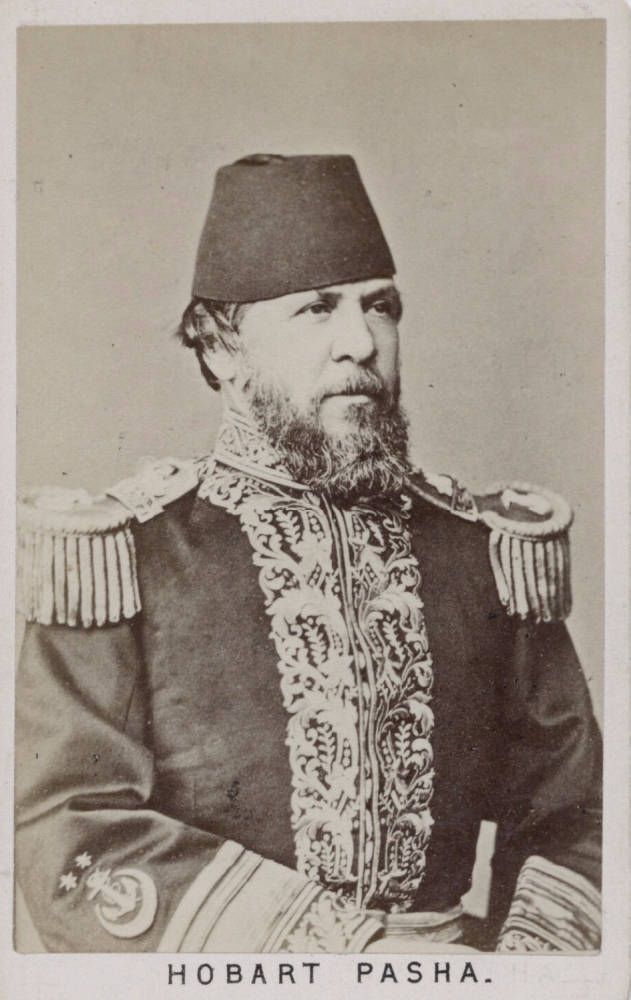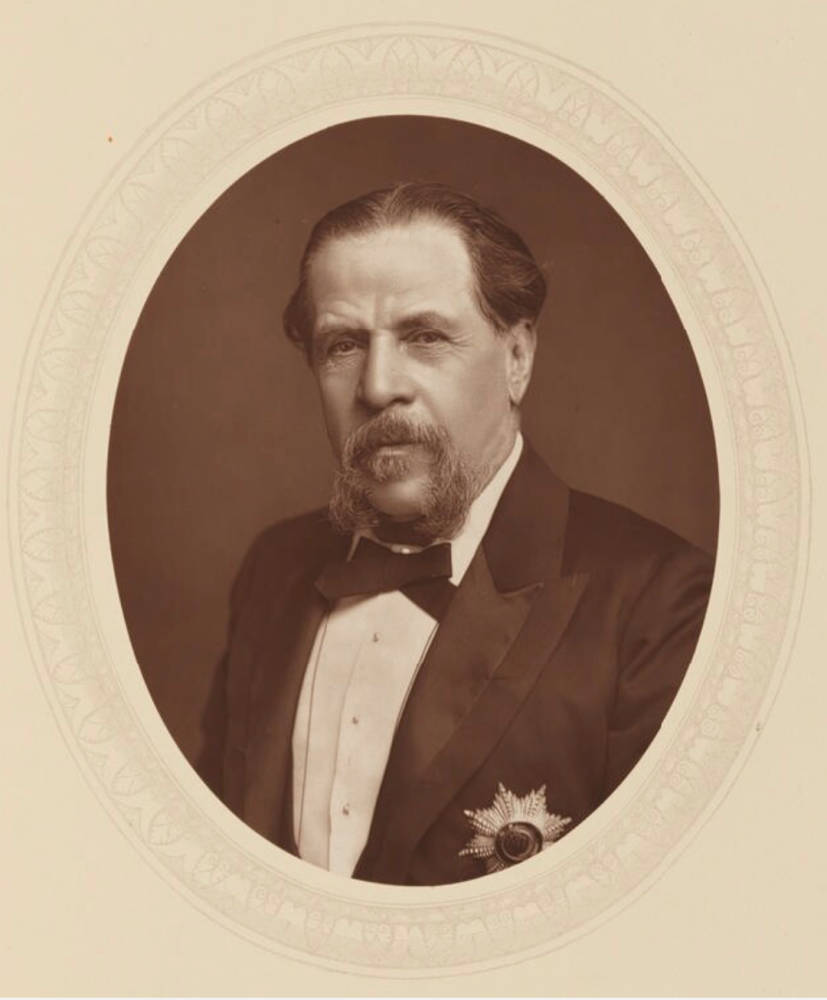In transcribing the following from the The Dictionary of National Biography I have relied on the Hathi Trust’s online version and its invaluable OCR text and and added links to the material on this site. Many thanks top Patrick Leary, founder and director of Victoria for his advice and assistance. Please notify the webmaster if you encounter typographical errors. — George P. Landow

ugustus Charles Hobart-Hampden, commonly known as Hobart Pasha. admiral, third son and fourth child of Augustus Edward Hobart (later Hobart-Hampden), sixth earl of Buckinghamshire, was born at Walton-on-the-Wolds, Leicestershire, on 1 April 1822." His mother was Mary, daughter of John Williams, king's Serjeant, and sister to the judge Sir Edward Vaughan Williams. He went to Dr. Mayo's school at Cheam, Surrey, but according to his own confession (Sketches from my Life, 1887, p. 2) did not distinguish himself, and in 1835 he entered the royal navy, joining the Rover, 18 guns, at Devonport in February. The Rover was paid off at Plymouth in July 1838, and Hobart joined the Rose in October, became acting mate in July 1841, and, when paid off in July 1842, passed his examinations at the Naval College and on board the Excellent at Portsmouth. He qualified as gunnery-mate, and joined the Dolphin in the autumn of 1843.
His first three ships were all employed off the coast of South America in the suppression of the slave-trade. Rio de Janeiro was the busy centre of that commerce, and Hobart appears to have enjoyed his full share of adventure, although in his own account of this period of his career he much exaggerated and misrepresented the stirring events in which he engaged. His last genuine exploit during the slave-hunting period was to carry a slaver prize into Demerara in May 1844. He after wards returned to England, and was appointed to the queen's yacht as a reward for gallant conduct. In September 1845 he resumed active work as lieutenant on board the Rattler in the Mediterranean, and was transferred in 1847 to the Bulldog (Commander, afterwards Admiral Sir Cooper, Key), where he showed himself “full of zeal” (Sir W. Parker, Life, iii.323). On the outbreak of the Russian war Hobart served as first lieutenant on the same vessel in the Baltic squadron, and commanded the Driver for a fortnight (August 1854) at the reduction of Bomarsund and the reconnaissance at Åbo. His ship was commended in the despatches, and Hobart's “ability, zeal, and great exertion” at Åbo were specially mentioned. In 1855 he was on the Duke of Wellington, Admiral Dundas's flagship, and commanded the mortar-boats at the attack on Sveaborg (Helsingfors), for which he was again men tioned in despatches and was promoted to the rank of commander. Then for six yean he left the regular service of the navy and became officer of the coastguard at Dingle, Co. Kerry, and subsequently (1858-61) of the guardship at Malta. In 1861 he commanded the gun-vessel Foxhound in the Mediterranean, was promoted captain in March 1863, and immediately retired on half-pay. This was the end of his services in the British navy.
In spite of his family “interest” Hobart's rise had been very slow. He was clearly unsuited to the precise discipline and decorous subordination of the regular service; he was created for adventure and hairbreadth escapes: “A bold buccaneer of the Elizabethan period, who by some strange perverseness of fate was born in to the Victorian.” At the time of his retirement the civil war in America was beginning, and Hobart, who was a staunch Southerner, joined some brother officers in running the blockade off the coast of North Carolina. The daring and skilful seamanship by which he carried his cargoes into Wilmington and Charleston, the exciting chases and narrow escapes of this adventurous period, when Hobart was thoroughly in his proper element, may be read in “Never Caught” (1867), which he wrote under the pseudonym of ' Captain Roberts,' and which is practically reprinted in Sketches from my Life (pp. 87—186). American authorities state that this narrative is substantially accurate (Edinburgh Review No. 337, pp. 174-76).



Three Portraits of Hobart Pasha courtesy of the National Portrait Gallery London: Left: Carte-de-visite by Alexander James Grossmann. Middle: Woodburytype by Lock & Whitfield. Right: Caricature in Vanity Fair by Spy (Sir Leslie Ward, 1851-1922). [Click on images to enlarge them.]
In 1867, seeking a new career of adventure, Hobart entered the Turkish service as naval adviser to the sultan, in succession to Admiral Sir Adolphus Slade. His first work in this capacity was the suppression of the Cretan rebellion by a strategic intercepting of the supplies from Greece. For this service he was raised to the rank of full admiral, with the title of pasha (1869). The Turkish fleet was reorganised and improved under his direction, but in the war of 1877 the jealousy of the authorities pre vented him, as commander of the Black Sea fleet, from achieving any notable naval success, though he displayed considerable skill in baffling the Russian torpedoes, for which weapon he entertained a hearty contempt. In 1881 the sultan, who highly esteemed the admiral, appointed him mushir or marshal of the empire. Hochart's action against Greece in 1867 was a breach of the Foreign Enlistment Act, and he was accordingly struck off the British navy list. Restored to his naval rank in 1874 by Lord Derby's influence, he was again erased from the list in 1877 for having a second time defied the act by his command of the Black Sea fleet against Russia, a “friendly power,” but was finally restored in June 1885, with the rank of British vice-admiral. In that year he visited London with a view to forming an offensive alliance between England and Turkey at the time of the Fenjdeh incident in the Afghan crisis. In 1886 he went to Italy to recruit his health, but died at Milan on 19 June. Hobart was twice married: first (1848) to Mary Anne (d. 13 May 1877), second daughter of Br. Colquhoun Grant, and, secondly (1879), to Edith Katherine, daughter of Herbert Francis Hore of Pole Hore, co. Wexford, who edited his Sketches. Hobart's Sketches of My Life was issued posthumously in 1887. Many stirring episodes there described (pp. 17-70) belong to the period 1835-44; but the book is so strange and contradictory a mixture of fact and fiction that it is impossible to treat it as a serious autobiography. A writer in the Edinburgh Review (January 1887, No. 337), with full knowledge of the navy records, has subjected Hobart's reminiscences to an exhaustive criticism, and proves conclusively not only that he has unaccountably confused dates and places, but that he lays claim to experiences which he could never have had, and to exploits which were those of brother officers. Eith.er Hobart's memory was failing when he dictated these Sketches shortly before his death, or else he related whatever good stories occurred to him with the intention of authenticating and revising them afterwards, but was prevented by death. The tone of the book precluded the suggestion of intentional romancing. [Authorities quoted in the article; Times, 21 June 1886; Lodge's Peerage.] S. L.-P.
Related material
- “The policy of England in Egypt has been a gigantic and fatal error from beginning to end” from Blackwood's Edinburgh Magazine (by Hobart-Hampden_
- The Ottoman Empire (Turkey) — homepage.
Bibliography
L[ane]-P[oole], Stanley. “Hobart-Hampton, Augustus Charles.” The Dictionary of National Biography. Ed. Sir Leslie Stephen and Sir Sidney Lee. 22 vols. London, H. Milford, 1921-22. 9.930-31. Hathi Trust Digital Library. Web. 6 September 2020.
Last modified 6 September 2020